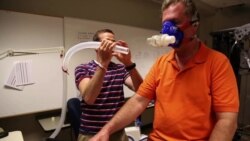An exercise routine common among athletes may also help people with chronic disease. That’s what 61-year old Canadian Michael Van Ziffle discovered when he enrolled in a study at the University of British Columbia's Okanagan campus that would train and monitor his progress with an exercise workout called HIIT, short for High Intensity Interval Training.
Exercise is beneficial at any time, at any age. It is known to regulate weight and protect against heart disease, certain cancers and diabetes. What’s different about HIIT is it alternates short, intense bursts of energy with periods of rest and recovery.
Van Ziffle exercised on a stationary bike, one minute of intense pedaling, followed by a minute at a slow, more leisurely pace. “I did not want diabetes,” he said, figuring the exercise could do him some good. He repeated the routine 10 times, three days a week, then increased to 12 sets by the end of the monthlong session.
UBC assistant professors John Little and Mary Jung are co-authors of a forthcoming study in the Journal of Diabetes Research, which documents the impact of HIIT for people with pre-diabetes like Van Ziffle. “We take a comprehensive approach,” Little said, explaining that they measured participants' oxygen uptake during exercise, as well as glucose and insulin levels in the blood.
Van Ziffle’s overall fitness improved 5 to 10 percent over the course of the study. “The results I’ve seen are my increased stamina, agility, strength and flexibility,” Van Ziffle reported. “It has lowered my blood pressure. I am able to [exercise] harder and not puff so much. It keeps me standing straighter and walking taller, you can say.” And, he’s lost weight. Similar results were recorded for other study participants, as compared with their counterparts who exercised at moderate intensity continuously without breaks.
Co-author Jung said the exercise also made HIIT participants feel better, not just physically but emotionally, too.
“They come in here. They are timid [and] often with guilt or shame that they haven’t been exercising for several years. [Then] they begin to see themselves as an exerciser, and so once these individuals have an identity, that ‘I am a fit, healthy person,’ that goes a long way in motivating them to continue to exercise long past the study end.”
That was true for Van Ziffle. “I was truly elated to realize that I could push my body to the end limit ... bounce back and actually find I had created new end limit for myself,” he said.
Van Ziffle has integrated HIIT into his regular exercise routine more than a year after the study. The researchers say their study shows HIIT is not just for athletes. It holds promise for people with chronic disease.










